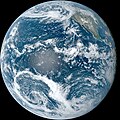Pacific Ocean: Difference between revisions
CSV import Tags: mobile edit mobile web edit |
CSV import |
||
| Line 38: | Line 38: | ||
{{stub}} | {{stub}} | ||
{{dictionary-stub1}} | {{dictionary-stub1}} | ||
<gallery> | |||
File:Pacific_Ocean_-_en.png|Pacific Ocean | |||
File:Pacific_Ocean_as_viewed_from_GOES-18_on_September_23,_2023.jpg|Pacific Ocean | |||
File:Fijian_double_canoe,_model,_Otago_Museum,_2016-01-29.jpg|Fijian double canoe model | |||
File:Chronological_dispersal_of_Austronesian_people_across_the_Pacific.svg|Chronological dispersal of Austronesian people across the Pacific | |||
File:Waldseemuller_map_2.jpg|Waldseemüller map | |||
File:Carta_universal_en_que_se_contiene_todo_lo_que_del_mundo_se_ha_descubierto_fasta_agora_hizola_Diego_Ribero_cosmographo_de_su_magestad,_ano_de_1529,_en_Sevilla.jpg|Carta universal by Diego Ribero, 1529 | |||
File:A_compleat_chart_of_the_coast_of_Asia_and_America_with_the_great_South_Sea_-_R.W._Seale_del._et_sculp._NYPL465242.tiff|A compleat chart of the coast of Asia and America with the great South Sea | |||
File:Ortelius_-_Maris_Pacifici_1589.jpg|Ortelius - Maris Pacifici, 1589 | |||
File:A_generall_chart_of_the_South_Sea_..._NYPL481132.tiff|A generall chart of the South Sea | |||
File:Trieste_(23_Jan_1960).jpeg|Trieste, 23 Jan 1960 | |||
File:TahitiDupetitThouars.jpg|Tahiti by Dupetit Thouars | |||
File:Iss007e10807.jpg|Pacific Ocean | |||
</gallery> | |||
Latest revision as of 12:02, 18 February 2025
Pacific Ocean
The Pacific Ocean is the largest and deepest of Earth's oceanic divisions. It extends from the Arctic Ocean in the north to the Southern Ocean (or, depending on definition, to Antarctica) in the south and is bounded by the continents of Asia and Australia in the west and the Americas in the east.
At 165,250,000 square kilometers (63,800,000 square miles) in area (as defined with an Antarctic southern border), this largest division of the World Ocean—and, in turn, the hydrosphere—covers about 46% of Earth's water surface and about one-third of its total surface area, making it larger than all of Earth's land area combined. The centers of both the Water hemisphere and the Western Hemisphere are in the Pacific Ocean. Its mean depth is 4,000 meters (13,000 feet).Challenger Deep in the Mariana Trench, located in the western north Pacific, is the deepest point in the world, reaching a depth of 10,928 meters (35,853 feet).
The Pacific Ocean was named by explorer Ferdinand Magellan who named it mar pacifico in Portuguese, meaning "peaceful sea".
Geography[edit]
The Pacific Ocean encompasses approximately one-third of the Earth's surface, having an area of 165,200,000 km2 (63,800,000 sq mi)—larger than Earth's entire landmass combined, 148,000,000 km2 (57,000,000 sq mi). It is about 15 times the size of the US.
Climate[edit]
The climate patterns of the Northern and Southern Hemispheres generally mirror each other. The trade winds in the southern and eastern Pacific are remarkably steady while conditions in the North Pacific are far more varied with, for example, cold winter temperatures on the east coast of Russia contrasting with the milder weather off British Columbia during the winter months due to the preferred flow of ocean currents.
Flora and fauna[edit]
The Pacific Ocean has a variety of flora and fauna. It is home to a rich variety of fish, whales, dolphins, seals, and other marine animals. Many species of sharks and rays also inhabit the Pacific, with the Great White Shark being perhaps the most famous.
See also[edit]
References[edit]
<references />
External links[edit]
|
|
|
-
Pacific Ocean
-
Pacific Ocean
-
Fijian double canoe model
-
Chronological dispersal of Austronesian people across the Pacific
-
Waldseemüller map
-
Carta universal by Diego Ribero, 1529
-
A compleat chart of the coast of Asia and America with the great South Sea
-
Ortelius - Maris Pacifici, 1589
-
A generall chart of the South Sea
-
Trieste, 23 Jan 1960
-
Tahiti by Dupetit Thouars
-
Pacific Ocean














